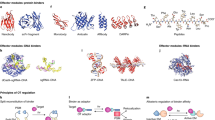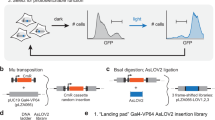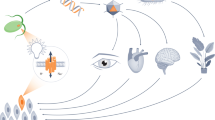Abstract
Optogenetic gene expression systems can control transcription with spatial and temporal detail unequaled with traditional inducible promoter systems. However, current eukaryotic light-gated transcription systems are limited by toxicity, dynamic range or slow activation and deactivation. Here we present an optogenetic gene expression system that addresses these shortcomings and demonstrate its broad utility. Our approach uses an engineered version of EL222, a bacterial light-oxygen-voltage protein that binds DNA when illuminated with blue light. The system has a large (>100-fold) dynamic range of protein expression, rapid activation (<10 s) and deactivation kinetics (<50 s) and a highly linear response to light. With this system, we achieve light-gated transcription in several mammalian cell lines and intact zebrafish embryos with minimal basal gene activation and toxicity. Our approach provides a powerful new tool for optogenetic control of gene expression in space and time.
This is a preview of subscription content, access via your institution
Access options
Subscribe to this journal
Receive 12 print issues and online access
$259.00 per year
only $21.58 per issue
Buy this article
- Purchase on Springer Link
- Instant access to full article PDF
Prices may be subject to local taxes which are calculated during checkout





Similar content being viewed by others
References
Weber, W. & Fussenegger, M. Inducible product gene expression technology tailored to bioprocess engineering. Curr. Opin. Biotechnol. 18, 399–410 (2007).
Weber, W. & Fussenegger, M. Emerging biomedical applications of synthetic biology. Nat. Rev. Genet. 13, 21–35 (2012).
Briggs, W.R. & Spudich, J.L. Handbook of Photosensory Receptors (Wiley-VCH, 2005).
Shimizu-Sato, S., Huq, E., Tepperman, J.M. & Quail, P.H. A light-switchable gene promoter system. Nat. Biotechnol. 20, 1041–1044 (2002).
Levskaya, A. et al. Synthetic biology: engineering Escherichia coli to see light. Nature 438, 441–442 (2005).
Yazawa, M., Sadaghiani, A.M., Hsueh, B. & Dolmetsch, R.E. Induction of protein-protein interactions in live cells using light. Nat. Biotechnol. 27, 941–945 (2009).
Kennedy, M.J. et al. Rapid blue-light-mediated induction of protein interactions in living cells. Nat. Methods 7, 973–975 (2010).
Ye, H., Daoud-El Baba, M., Peng, R.W. & Fussenegger, M. A synthetic optogenetic transcription device enhances blood-glucose homeostasis in mice. Science 332, 1565–1568 (2011).
Ohlendorf, R., Vidavski, R.R., Eldar, A., Moffat, K. & Moglich, A. From dusk till dawn: one-plasmid systems for light-regulated gene expression. J. Mol. Biol. 416, 534–542 (2012).
Wang, X., Chen, X. & Yang, Y. Spatiotemporal control of gene expression by a light-switchable transgene system. Nat. Methods 9, 266–269 (2012).
Polstein, L.R. & Gersbach, C.A. Light-inducible spatiotemporal control of gene activation by customizable zinc finger transcription factors. J. Am. Chem. Soc. 134, 16480–16483 (2012).
Liu, H., Gomez, G., Lin, S., Lin, S. & Lin, C. Optogenetic control of transcription in zebrafish. PLoS ONE 7, e50738 (2012).
Nash, A.I. et al. Structural basis of photosensitivity in a bacterial light-oxygen-voltage/helix-turn-helix (LOV-HTH) DNA-binding protein. Proc. Natl. Acad. Sci. USA 108, 9449–9454 (2011).
Huala, E. et al. Arabidopsis NPH1—a protein kinase with a putative redox-sensing domain. Science 278, 2120–2123 (1997).
Rivera-Cancel, G., Motta-Mena, L.B. & Gardner, K.H. Identification of natural and artificial DNA substrates for light-activated LOV-HTH transcription factor EL222. Biochemistry 51, 10024–10034 (2012).
Zoltowski, B.D., Motta-Mena, L.B. & Gardner, K.H. Blue light–induced dimerization of a bacterial LOV-HTH DNA-binding protein. Biochemistry 52, 6653–6661 (2013).
Zoltowski, B.D., Nash, A.I. & Gardner, K.H. Variations in protein-flavin hydrogen bonding in a light, oxygen, voltage domain produce non-Arrhenius kinetics of adduct decay. Biochemistry 50, 8771–8779 (2011).
Sadowski, I., Ma, J., Triezenberg, S. & Ptashne, M. GAL4–VP16 is an unusually potent transcriptional activator. Nature 335, 563–564 (1988).
Sadowski, I., Bell, B., Broad, P. & Hollis, M. GAL4 fusion vectors for expression in yeast or mammalian cells. Gene 118, 137–141 (1992).
Swanson, B., Fan, F. & Wood, K. in Promega Corporation Vol. 17 3–5 (Cell Notes, 2007).
Chen, E., Swartz, T.E., Bogomolni, R.A. & Kliger, D.S.A. LOV story: the signaling state of the phot1 LOV2 photocycle involves chromophore-triggered protein structure relaxation, as probed by far-UV time-resolved optical rotatory dispersion spectroscopy. Biochemistry 46, 4619–4624 (2007).
Kennis, J.T. et al. Primary reactions of the LOV2 domain of phototropin, a plant blue-light photoreceptor. Biochemistry 42, 3385–3392 (2003).
Harper, S.M., Neil, L.C., Day, I.J., Hore, P.J. & Gardner, K.H. Conformational changes in a photosensory LOV domain monitored by time-resolved NMR spectroscopy. J. Am. Chem. Soc. 126, 3390–3391 (2004).
Pan, Y.X., Chen, H. & Kilberg, M.S. Interaction of RNA-binding proteins HuR and AUF1 with the human ATF3 mRNA 3′-untranslated region regulates its amino acid limitation-induced stabilization. J. Biol. Chem. 280, 34609–34616 (2005).
Qian, X. et al. Posttranscriptional regulation of IL-23 expression by IFN-γ through tristetraprolin. J. Immunol. 186, 6454–6464 (2011).
Thompson, J.F., Hayes, L.S. & Lloyd, D.B. Modulation of firefly luciferase stability and impact on studies of gene regulation. Gene 103, 171–177 (1991).
Larson, D.R., Zenklusen, D., Wu, B., Chao, J.A. & Singer, R.H. Real-time observation of transcription initiation and elongation on an endogenous yeast gene. Science 332, 475–478 (2011).
Lynch, K.W. & Weiss, A. A model system for activation-induced alternative splicing of CD45 pre-mRNA in T cells implicates protein kinase C and Ras. Mol. Cell. Biol. 20, 70–80 (2000).
Ip, J.Y. et al. Global analysis of alternative splicing during T-cell activation. RNA 13, 563–572 (2007).
Martinez, N.M. et al. Alternative splicing networks regulated by signaling in human T cells. RNA 18, 1029–1040 (2012).
Faustino, N.A. & Cooper, T.A. Identification of putative new splicing targets for ETR-3 using sequences identified by systematic evolution of ligands by exponential enrichment. Mol. Cell. Biol. 25, 879–887 (2005).
Mallory, M.J. et al. Signal- and development-dependent alternative splicing of LEF1 in T cells is controlled by CELF2. Mol. Cell. Biol. 31, 2184–2195 (2011).
Dembowski, J.A. & Grabowski, P.J. The CUGBP2 splicing factor regulates an ensemble of branchpoints from perimeter binding sites with implications for autoregulation. PLoS Genet. 5, e1000595 (2009).
Yelon, D., Horne, S.A. & Stainier, D.Y. Restricted expression of cardiac myosin genes reveals regulated aspects of heart tube assembly in zebrafish. Dev. Biol. 214, 23–37 (1999).
Harper, S.M., Neil, L.C. & Gardner, K.H. Structural basis of a phototropin light switch. Science 301, 1541–1544 (2003).
Scheuermann, T.H. et al. Allosteric inhibition of hypoxia inducible factor-2 with small molecules. Nat. Chem. Biol. 9, 271–276 (2013).
Mattis, J. et al. Principles for applying optogenetic tools derived from direct comparative analysis of microbial opsins. Nat. Methods 9, 159–172 (2012).
Loew, R., Heinz, N., Hampf, M., Bujard, H. & Gossen, M. Improved Tet-responsive promoters with minimized background expression. BMC Biotechnol. 10, 81 (2010).
Konermann, S. et al. Optical control of mammalian endogenous transcription and epigenetic states. Nature 500, 472–476 (2013).
Krueger, M., Scholz, O., Wisshak, S. & Hillen, W. Engineered Tet repressors with recognition specificity for the tetO-4C5G operator variant. Gene 404, 93–100 (2007).
Lynch, K.W. & Weiss, A.A. CD45 polymorphism associated with multiple sclerosis disrupts an exonic splicing silencer. J. Biol. Chem. 276, 24341–24347 (2001).
Bookout, A.L. & Mangelsdorf, D.J. Quantitative real-time PCR protocol for analysis of nuclear receptor signaling pathways. Nucl. Recept. Signal. 1, e012 (2003).
Schneider, C.A., Rasband, W.S. & Eliceiri, K.W. NIH Image to ImageJ: 25 years of image analysis. Nat. Methods 9, 671–675 (2012).
Westerfield, M. The Zebrafish Book. A Guide for the Laboratory Use of Zebrafish (Danio rerio) 5th edn. (The University of Oregon Press, 2007).
Balciunas, D. et al. Harnessing a high cargo-capacity transposon for genetic applications in vertebrates. PLoS Genet. 2, e169 (2006).
Huang, C.J., Tu, C.T., Hsiao, C.D., Hsieh, F.J. & Tsai, H.J. Germ-line transmission of a myocardium-specific GFP transgene reveals critical regulatory elements in the cardiac myosin light chain 2 promoter of zebrafish. Dev. Dyn. 228, 30–40 (2003).
Maizel, A., von Wangenheim, D., Federici, F., Haseloff, J. & Stelzer, E.H. High-resolution live imaging of plant growth in near physiological bright conditions using light sheet fluorescence microscopy. Plant J. 68, 377–385 (2011).
Acknowledgements
This work was funded by grants from the US National Institutes of Health (R01 GM081875 and GM106239 to K.H.G.; R01 GM103383 to K.W.L.; R01 GM096164 to O.D.W.), Cancer Prevention and Research Institute of Texas (RP130312), Defense Advanced Research Projects Agency (Living Foundries HR0011-12-C-0068 to B. Chow (University of Pennsylvania), supporting S.G.) and the Robert A. Welch Foundation (I-1424 to K.H.G.). K.H.G. is the Virginia Lazenby O'Hara Chair in Biochemistry and W.W. Caruth Scholar in Biomedical Research. A.R. was supported by a National Science Foundation Graduate Research Fellowship. We thank S.L. McKnight and P.R. Potts (both at UT Southwestern Medical Center) for generously providing constructs.
Author information
Authors and Affiliations
Contributions
L.B.M.-M., A.R., O.D.W., K.W.L. and K.H.G. conceived and designed the experiments. L.B.M.-M., A.R. and M.J.M. performed the experiments. L.B.M.-M., A.R., M.J.M., O.D.W., K.W.L. and K.H.G. analyzed the data, with S.G. and K.H.G. generating the kinetic model. L.B.M.-M. and K.H.G. wrote the paper.
Corresponding author
Ethics declarations
Competing interests
L.B.M.M. and K.H.G. have filed US Patent Application PCT/US2012/065493 covering the method described in this paper.
Supplementary information
Supplementary Text and Figures
Supplementary Results, Supplementary Figures 1–5, Supplementary Table 1 and Supplementary Notes 1 and 3. (PDF 2701 kb)
Supplementary Note 2
MATLAB code for kinetic model (DOC 28 kb)
Supplementary Video 1
Z-stack of 70% epiboly embryo showing mosaic expression of mCherry after illumination with blue light. (AVI 20581 kb)
Supplementary Video 2
Z-stack of 70% epiboly embryo showing no expression of mCherry under dark conditions. (AVI 24709 kb)
Supplementary Video 3
Localization of fluorescent mCherry in the heart of a developing zebrafish embryo at 24 h.p.f. (AVI 399 kb)
Rights and permissions
About this article
Cite this article
Motta-Mena, L., Reade, A., Mallory, M. et al. An optogenetic gene expression system with rapid activation and deactivation kinetics. Nat Chem Biol 10, 196–202 (2014). https://doi.org/10.1038/nchembio.1430
Received:
Accepted:
Published:
Issue Date:
DOI: https://doi.org/10.1038/nchembio.1430
This article is cited by
-
Optogenetic spatial patterning of cooperation in yeast populations
Nature Communications (2024)
-
In vivo imaging of inflammatory response in cancer research
Inflammation and Regeneration (2023)
-
Multidimensional characterization of inducible promoters and a highly light-sensitive LOV-transcription factor
Nature Communications (2023)
-
Accessible light-controlled knockdown of cell-free protein synthesis using phosphorothioate-caged antisense oligonucleotides
Communications Chemistry (2023)
-
Maximizing protein production by keeping cells at optimal secretory stress levels using real-time control approaches
Nature Communications (2023)



